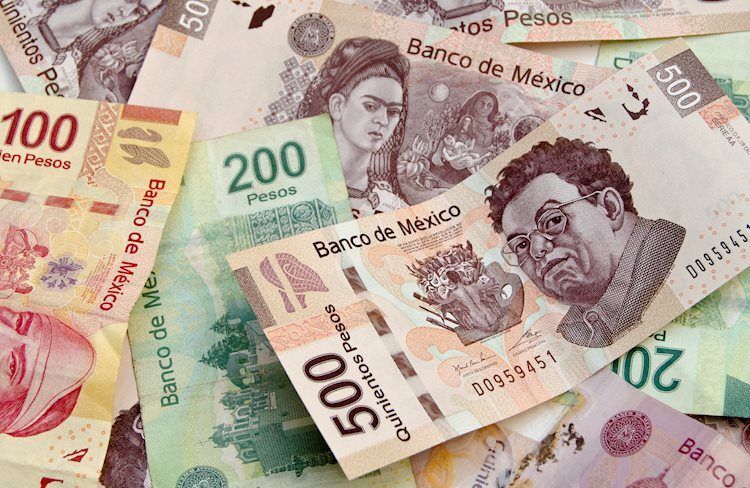- Mexican Peso on the defensive as September inflation aims toward Banxico’s 3% goal.
- Banxico is expected to lower rates further after cutting to 10.50% in September, with additional easing projected by the end of 2024.
- The Fed’s September meeting minutes, sponsored a leg-up in the USD/MXN to 19.48.
The Mexican peso depreciated against the US Dollar on Wednesday following an inflation report that opened the door for further easing by the Bank of Mexico (Banxico). Meanwhile, the Federal Reserve (Fed) revealed its September Meeting Minutes. The USD/MXN trades at 19.48, up over 0.70%.
Mexico’s inflation edged lower in September, according to the Instituto Nacional de Estadistica Geografia e Informatica (INEGI). Headline and Core Consumer Price Index (CPI) readings came below estimates and trended toward hitting Banxico’s 3% plus or minus 1% goal.
The USD/MXN aimed higher as the data hints that Banxico could be more aggressive on its easing cycle. On Monday, Banxico Governor Victoria Rodriguez said the governing board may consider larger cuts to its benchmark rate as she spoke to Reuters.
Banxico lowered rates to 10.50% in September and is expected to ease at least an additional 50 basis points (bps) toward the end of 2024. The following meetings will be on November 14 and December 19.
The Fed’s September 17-18 Meeting Minutes in the US, showed that some officials would have preferred a 25-basis-point (bps) rate cut; all participants agreed on the need to lower interest rates. Regarding the Fed’s dual mandate, nearly all officials saw inflation risks tilted to the downside, whereas risks to the labor market were seen as tilted to the upside.
Following last Friday’s Nonfarm Payrolls (NFP) report, Fed officials adopted a more cautious stance. On Tuesday, Vice-Chairman Philip Jefferson said he remains data-dependent and that his approach will be meeting by meeting. Boston Fed President Susan Collins said further cuts are likely needed, but they would be data-driven.
In the meantime, the US Dollar Index (DXY), which tracks the buck’s performance against the other six currencies, climbs 0.37% to 102.85, underpinned by the jump in US Treasury yields.
Daily digest market movers: Mexican Peso tumbles following inflation report
- Last Thursday, Mexico’s Supreme Court voted eight to three to “consider a constitutional challenge to the controversial judicial overhaul enacted last month,” which would allow the election of judges and Supreme Court magistrates through electoral vote.
- Mexico’s CPI in September dipped from 4.99% to 4.58% YoY, exceeding estimates of 4.62%. Monthly inflation was 0.05%, below projections of 0.1%.
- Core CPI expanded by 3.91% YoY, below forecasts of 3.95%. Monthly core inflation was 0.28%, up from 0.22% but below estimates of 0.32%.
- According to Banxico’s poll, the central bank is projected to lower rates by 50 bps to 10% for the remainder of 2024. Meanwhile, the USD/MXN exchange rate will end at around 19.69.
- Mexico’s economy is projected to grow by 1.45% in 2024, lower than August’s 1.57%.
- Data from the Chicago Board of Trade (CBOT) via the December fed funds rate futures contract shows investors estimate 48 bps of easing by the Fed toward the end of 2024.
- Market participants have disregarded a 50 bps cut. The odds of a 25 bps cut are 81.4%, while the chances for holding rates unchanged are at 18.6%, according to the CME FedWatch Tool data.
USD/MXN technical outlook: Mexican Peso extends losses as USD/MXN jumps above 19.40
The USD/MXN regained the 50-day Simple Moving Average (SMA) at 19.37, which could open the door for further upside. Momentum favors buyers as depicted by the Relative Strength Index’s (RSI) bullish reading. Therefore, the exotic pair is headed to the upside.
If USD/MXN clears the psychological 19.50 level, look for buyers driving the exchange rate toward the October 1 daily high of 19.82, ahead of 20.00. Up next would be the YTD peak of 20.22.
For a bearish resumption, if USD/MXN drops below the October 4 wing low of 19.10, the 19.00 figure will be exposed. Once broken, the next support would be the 100-day SMA at 18.64.
Fed FAQs
Monetary policy in the US is shaped by the Federal Reserve (Fed). The Fed has two mandates: to achieve price stability and foster full employment. Its primary tool to achieve these goals is by adjusting interest rates. When prices are rising too quickly and inflation is above the Fed’s 2% target, it raises interest rates, increasing borrowing costs throughout the economy. This results in a stronger US Dollar (USD) as it makes the US a more attractive place for international investors to park their money. When inflation falls below 2% or the Unemployment Rate is too high, the Fed may lower interest rates to encourage borrowing, which weighs on the Greenback.
The Federal Reserve (Fed) holds eight policy meetings a year, where the Federal Open Market Committee (FOMC) assesses economic conditions and makes monetary policy decisions. The FOMC is attended by twelve Fed officials – the seven members of the Board of Governors, the president of the Federal Reserve Bank of New York, and four of the remaining eleven regional Reserve Bank presidents, who serve one-year terms on a rotating basis.
In extreme situations, the Federal Reserve may resort to a policy named Quantitative Easing (QE). QE is the process by which the Fed substantially increases the flow of credit in a stuck financial system. It is a non-standard policy measure used during crises or when inflation is extremely low. It was the Fed’s weapon of choice during the Great Financial Crisis in 2008. It involves the Fed printing more Dollars and using them to buy high grade bonds from financial institutions. QE usually weakens the US Dollar.
Quantitative tightening (QT) is the reverse process of QE, whereby the Federal Reserve stops buying bonds from financial institutions and does not reinvest the principal from the bonds it holds maturing, to purchase new bonds. It is usually positive for the value of the US Dollar.
Read the full article here

